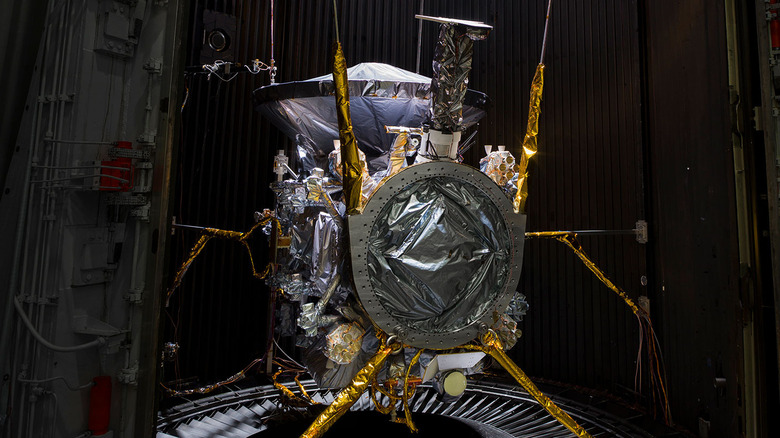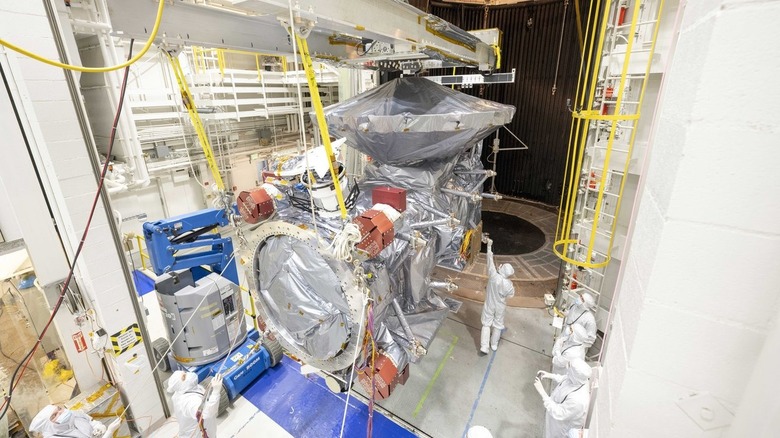Here's How NASA Tests Its Spacecraft For The Rigors Of Space Travel
Getting a spacecraft into space is no easy task. Just loading a large vehicle into a rocket can be a challenge, as there is only so much room available. Often, spacecraft have to be loaded in while they are folded up, so longer parts like antennae or solar panels can be unfurled once the spacecraft is deployed from the rocket and in space.
The launch itself often involves high temperatures as the rocket shoots through Earth's atmosphere, not to mention the extreme vibrations that can shake parts loose. Then, once in space, the spacecraft has to cope with the extreme conditions of vacuum and freezing temperatures. For most launches, you only get one shot, so space agencies need to make sure that their spacecraft can survive the drama of launch and the harsh environment of space before they ever get off the ground. After all, there are no repair shops beyond Earth.
NASA recently discussed some of the techniques it uses in testing spacecraft to get them ready for space while they're still on the ground. Using the Europa Clipper spacecraft destined for Jupiter's moon later this year, the agency revealed how it goes about ensuring spacecraft can survive the grueling process of launch and travel that they have to get through before they can ever start collecting science data — in this case, aiming to study Jupiter's icy moon to learn about the liquid water ocean that is thought to exist beneath a thick, icy shell and perhaps even uncovering clues about its habitability.
Testing for extremes
The Europa Clipper spacecraft recently went through a battery of tests called environmental testing, which simulates the space environment to check whether there are any issues that could result in the spacecraft being damaged or unable to complete its mission. Over the course of 16 days, the spacecraft underwent tests like being put inside a thermal vacuum chamber that recreates the vacuum of space. One challenge was simply getting the spacecraft to fit inside the chamber, which is 85 feet tall and 25 feet wide. Fully deployed, the spacecraft's arms spread over more than 100 feet, so these weren't included in the test chamber, but even without the arms Clipper was still one of the largest spacecraft ever put into the chamber.
As well as a vacuum, the spacecraft was exposed to high temperatures using powerful lamps, which simulate the blasting rays of the sun that the spacecraft will experience on one side as it travels through space, particularly when it is close to Earth. As it travels out toward Jupiter, the rays of the sun will become less powerful as it gets further away.
"These were the last big tests to find any flaws," said Europa Clipper project manager Jordan Evans of NASA JPL. "Our engineers executed a well-designed and challenging set of tests that put the system through its paces. What we found is that the spacecraft can handle the environments that it will see during and after launch. The system performed very well and operates as expected."
More challenges of space
It isn't only heat and vacuum that can cause problems for spacecraft once they're deployed, though. As the spacecraft travels away from Earth it will have to deal with dropping temperatures, which can be their own challenge. To simulate this, the lamps were gradually dimmed in the chamber and liquid nitrogen was used to drop the temperature down low. Electronics can stop working in low temperatures, so to keep essential components like computers warm in space, spacecraft have heating mechanisms. The tests probed whether the spacecraft's 500 temperature sensors could accurately detect the changing temperatures and warm itself sufficiently to keep all its components operating.
There were more trials for the spacecraft after that, though, even once it had left the thermal vacuum chamber. It had to go through testing for vibrations, shocks, and acoustics, in which it was shaken and jiggled to simulate the shaking that would occur during launch, as the rocket travels through the Earth's atmosphere. It was also bombarded with sound, as launches are very noisy and such high noise levels can cause damage to components. And to top all this off, the spacecraft was jolted with pyrotechnics to simulate the jolt of being separated from the rocket. The results look positive, with Europa Clipper surviving its harsh testing and getting ready for launch later this year.

